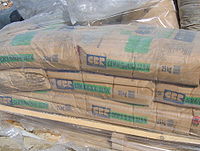
Photo from wikipedia
Abstract Sulfate is one of the most important chemical risks which affect the durability of concrete and reinforced concrete structures. Therefore, this study investigates the effects of sulfate on blended… Click to show full abstract
Abstract Sulfate is one of the most important chemical risks which affect the durability of concrete and reinforced concrete structures. Therefore, this study investigates the effects of sulfate on blended cement mortars. In this paper, cement mortar specimens were prepared with the substitution of CEM I 42.5 R cement with Fly ash + Bottom ash + Blast-furnace Slag at the ratios of 5%, 10%, 15%, and 20% along with a control specimen without additives. These prepared cement mortar specimens were then cured for 2, 7, 28, 90, 180, and 360 days either in potable water or 10% sodium sulfate (Na2SO4) solution. Cement paste specimens were subjected to the initial setting, final setting, and volumetric expansion tests in accordance with the TS EN 196-3 standard. Cured for 2, 7, 28, 90, 180, and 360 days, cement mortars were subjected to compressive strength tests as per the TS EN 196-1 standard while length change tests were conducted as per the ASTM C 1012 standard. It was found that the compressive strength of cement mortars blended with 5% Fly ash + Bottom ash + Blast-furnace Slag cured in sodium sulfate for 360 days was approximately 2% higher than that of the cement mortar without additives. The length change of specimens obtained from cured in sodium sulfate solution shows best results in higher additive ratio. These all length changes ratio are greater than 0.087% ratio which is maximum length change expansion in potable water. This study suggests that 15% and 20% additive ratios are effective in reducing unfavorable effects of sulfate.
Journal Title: Engineering Science and Technology, an International Journal
Year Published: 2018
Link to full text (if available)
Share on Social Media: Sign Up to like & get
recommendations!